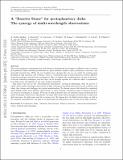Files in this item
A 'Rosetta Stone' for protoplanetary disks : the synergy of multi-wavelength observations
Item metadata
| dc.contributor.author | Sicilia-Aguilar, A. | |
| dc.contributor.author | Banzatti, A. | |
| dc.contributor.author | Carmona, A. | |
| dc.contributor.author | Stolker, T. | |
| dc.contributor.author | Kama, M. | |
| dc.contributor.author | Mendigutía, I | |
| dc.contributor.author | Garufi, A. | |
| dc.contributor.author | Flaherty, K. | |
| dc.contributor.author | Marel, N. van der | |
| dc.contributor.author | Greaves, J. | |
| dc.date.accessioned | 2017-06-13T23:35:57Z | |
| dc.date.available | 2017-06-13T23:35:57Z | |
| dc.date.issued | 2016-12-13 | |
| dc.identifier | 247488979 | |
| dc.identifier | 19bef956-1793-4a4e-9764-f9a4581ca719 | |
| dc.identifier | 85004011314 | |
| dc.identifier | 000390808600001 | |
| dc.identifier.citation | Sicilia-Aguilar , A , Banzatti , A , Carmona , A , Stolker , T , Kama , M , Mendigutía , I , Garufi , A , Flaherty , K , Marel , N V D & Greaves , J 2016 , ' A 'Rosetta Stone' for protoplanetary disks : the synergy of multi-wavelength observations ' , Publications of the Astronomical Society of Australia , vol. 33 , e059 . https://doi.org/10.1017/pasa.2016.56 | en |
| dc.identifier.issn | 1323-3580 | |
| dc.identifier.other | ArXiv: http://arxiv.org/abs/1611.01798v1 | |
| dc.identifier.uri | https://hdl.handle.net/10023/10988 | |
| dc.description.abstract | The recent progress in instrumentation and telescope development has brought us different ways to observe protoplanetary disks, including interferometers, space missions, adaptive optics, polarimetry, and time- and spectrally-resolved data. While the new facilities have changed the way we can tackle the existing open problems in disk structure and evolution, there is a substantial lack of interconnection between different observing techniques and their user communities. Here, we explore the complementarity of some of the state-of-the-art observing techniques, and how they can be brought together in a collective effort to understand how disks evolve and disperse at the time of planet formation. This paper was born at the "Protoplanetary Discussions" meeting in Edinburgh, 2016. Its goal is to clarify where multi-wavelength observations of disks converge in unveiling disk structure and evolution, and where they diverge and challenge our current understanding. We discuss caveats that should be considered when linking results from different observations, or when drawing conclusions based on limited datasets (in terms of wavelength or sample). We focus on disk properties that are currently being revolutionized by multi-wavelength observations. Specifically: the inner disk radius, holes and gaps and their link to large-scale disk structures, the disk mass, and the accretion rate. We discuss how the links between them, as well as the apparent contradictions, can help us to disentangle the disk physics and to learn about disk evolution. | |
| dc.format.extent | 31 | |
| dc.format.extent | 2212692 | |
| dc.language.iso | eng | |
| dc.relation.ispartof | Publications of the Astronomical Society of Australia | en |
| dc.subject | Protoplanetary disks | en |
| dc.subject | Methods: observational | en |
| dc.subject | Planets: formation | en |
| dc.subject | Astronomical instrumentation, methods and techniques | en |
| dc.subject | QB Astronomy | en |
| dc.subject | QC Physics | en |
| dc.subject | NDAS | en |
| dc.subject.lcc | QB | en |
| dc.subject.lcc | QC | en |
| dc.title | A 'Rosetta Stone' for protoplanetary disks : the synergy of multi-wavelength observations | en |
| dc.type | Journal article | en |
| dc.contributor.institution | University of St Andrews. School of Physics and Astronomy | en |
| dc.contributor.institution | University of St Andrews. St Andrews Centre for Exoplanet Science | en |
| dc.identifier.doi | 10.1017/pasa.2016.56 | |
| dc.description.status | Peer reviewed | en |
| dc.date.embargoedUntil | 2017-06-13 |
This item appears in the following Collection(s)
Items in the St Andrews Research Repository are protected by copyright, with all rights reserved, unless otherwise indicated.

